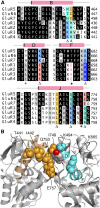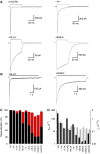Stability of ligand-binding domain dimer assembly controls kainate receptor desensitization
- PMID: 19339989
- PMCID: PMC2688536
- DOI: 10.1038/emboj.2009.86
Stability of ligand-binding domain dimer assembly controls kainate receptor desensitization
Abstract
AMPA and kainate receptors mediate fast synaptic transmission. AMPA receptor ligand-binding domains form dimers, which are key functional units controlling ion-channel activation and desensitization. Dimer stability is inversely related to the rate and extent of desensitization. Kainate and AMPA receptors share common structural elements, but functional measurements suggest that subunit assembly and gating differs between these subtypes. To investigate this, we constructed a library of GluR6 kainate receptor mutants and directly measured changes in kainate receptor dimer stability by analytical ultracentrifugation, which, combined with electrophysiological experiments, revealed an inverse correlation between dimer stability and the rate of desensitization. We solved crystal structures for a series of five GluR6 mutants, to understand the molecular mechanisms for dimer stabilization. We demonstrate that the desensitized state of kainate receptors acts as a deep energy well offsetting the stabilizing effects of dimer interface mutants, and that the deactivation of kainate receptor responses is dominated by entry into desensitized states. Our results show how neurotransmitter receptors with similar structures and gating mechanisms can exhibit strikingly different functional properties.
Figures









Similar articles
-
Interface interactions modulating desensitization of the kainate-selective ionotropic glutamate receptor subunit GluR6.J Neurosci. 2006 Sep 27;26(39):10033-42. doi: 10.1523/JNEUROSCI.2750-06.2006. J Neurosci. 2006. PMID: 17005866 Free PMC article.
-
Energetics of glutamate receptor ligand binding domain dimer assembly are modulated by allosteric ions.Proc Natl Acad Sci U S A. 2009 Jul 28;106(30):12329-34. doi: 10.1073/pnas.0904175106. Epub 2009 Jul 15. Proc Natl Acad Sci U S A. 2009. PMID: 19617541 Free PMC article.
-
Conformational flexibility of the ligand-binding domain dimer in kainate receptor gating and desensitization.J Neurosci. 2011 Feb 23;31(8):2916-24. doi: 10.1523/JNEUROSCI.4771-10.2011. J Neurosci. 2011. PMID: 21414913 Free PMC article.
-
Lessons from crystal structures of kainate receptors.Neuropharmacology. 2017 Jan;112(Pt A):16-28. doi: 10.1016/j.neuropharm.2016.05.014. Epub 2016 May 26. Neuropharmacology. 2017. PMID: 27236079 Review.
-
Structural biology of kainate receptors.Neuropharmacology. 2021 Jun 1;190:108511. doi: 10.1016/j.neuropharm.2021.108511. Epub 2021 Mar 30. Neuropharmacology. 2021. PMID: 33798545 Review.
Cited by
-
NMDA receptor activation requires remodelling of intersubunit contacts within ligand-binding heterodimers.Nat Commun. 2011 Oct 11;2:498. doi: 10.1038/ncomms1512. Nat Commun. 2011. PMID: 21988914 Free PMC article.
-
Glutamate receptor desensitization is mediated by changes in quaternary structure of the ligand binding domain.Proc Natl Acad Sci U S A. 2013 Apr 9;110(15):5921-6. doi: 10.1073/pnas.1217549110. Epub 2013 Mar 25. Proc Natl Acad Sci U S A. 2013. PMID: 23530186 Free PMC article.
-
Structure, Function, and Pharmacology of Glutamate Receptor Ion Channels.Pharmacol Rev. 2021 Oct;73(4):298-487. doi: 10.1124/pharmrev.120.000131. Pharmacol Rev. 2021. PMID: 34753794 Free PMC article. Review.
-
Zinc potentiates GluK3 glutamate receptor function by stabilizing the ligand binding domain dimer interface.Neuron. 2012 Nov 8;76(3):565-78. doi: 10.1016/j.neuron.2012.08.027. Neuron. 2012. PMID: 23141068 Free PMC article.
-
Preferential assembly of heteromeric kainate and AMPA receptor amino terminal domains.Elife. 2017 Oct 23;6:e32056. doi: 10.7554/eLife.32056. Elife. 2017. PMID: 29058671 Free PMC article.
References
-
- Adams PD, Grosse-Kunstleve RW, Hung LW, Ioerger TR, McCoy AJ, Moriarty NW, Read RJ, Sacchettini JC, Sauter NK, Terwilliger TC (2002) PHENIX: building new software for automated crystallographic structure determination. Acta Crystallogr D Biol Crystallogr 58: 1948–1954 - PubMed
-
- Armstrong N, Gouaux E (2000) Mechanisms for activation and antagonism of an AMPA-sensitive glutamate receptor: crystal structures of the GluR2 ligand binding core. Neuron 28: 165–181 - PubMed
-
- Armstrong N, Jasti J, Beich-Frandsen M, Gouaux E (2006) Measurement of conformational changes accompanying desensitization in an ionotropic glutamate receptor. Cell 127: 85–97 - PubMed
Publication types
MeSH terms
Substances
Grants and funding
LinkOut - more resources
Full Text Sources

